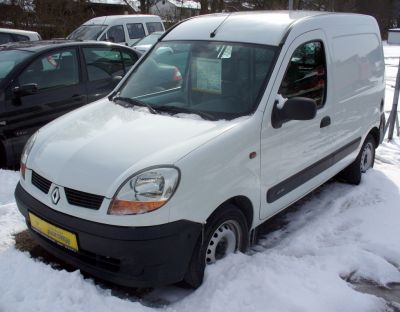 2003 Renault Kangoo I (KC, facelift 2003) Dimensions, Size & Specs
2003 Renault Kangoo I (KC, facelift 2003) Dimensions, Size & SpecsMeasurements of the 2003 Renault Kangoo I, engineered for optimal performance and comfort
| Dimensions | |
|---|---|
| Length: | 4035 mm158.9 in13.2 ft |
| Width: | 1672 mm65.8 in5.5 ft |
| Width (Opened Mirrors): | 2031 mm80.0 in6.7 ft |
| Height: | 1835-1885 mm72.2-74.2 in6.0-6.2 ft |
| Trunk Capacity: | 550-650 liter19.4-23.0 cu ft |
| Trunk Capacity (Max): | 2500-2600 liter88.3-91.8 cu ft |
| Weight Specifications | |
| Curb Weight: | 1020-1330 kg2249-2932 lbs |
| Maximal permitted Weight: | 1570-1860 kg3461-4101 lbs |
| Roof Load: | 100 kg220 lbs |
| Tire Specifications | |
| Rims Size: | 14-inch rims:
|
| Tire Sizes: |
|
The Renault Kangoo I (KC), facelifted in 2003 and produced until 2005, is a practical and versatile minivan well-suited for urban and family use. With an exterior length of 4035 mm (158.9 inches) and a width of 1672 mm (65.8 inches), it offers a compact footprint ideal for city driving. When including the opened mirrors, the width expands to 2031 mm (79.9 inches), which is useful to consider in tight parking spaces. The height ranges from 1835 to 1885 mm (72.2 to 74.2 inches), allowing for a spacious interior and comfortable headroom.
The curb weight varies between 1020 kg to 1330 kg (2249 to 2932 lbs), depending on equipment and configuration, while the maximum allowed weight ranges from 1570 kg to 1860 kg (3462 to 4101 lbs), supporting substantial payload capacity. One of the Kangoo’s standout features is its flexible luggage capacity, starting at 550 liters (19.4 cubic feet) with all seats in place, expanding to an impressive 2500 to 2600 liters (88.3 to 91.7 cubic feet) when the rear seats are folded down. This makes it an excellent choice for both everyday errands and larger cargo needs.
Additional practical details include a roof load capacity of 100 kg (220 lbs), allowing for extra storage options such as roof boxes or bike carriers. The standard wheel setup features 5.5J x 14 rims fitted with either 165/70 R14 C or 175/65 R14 tires, providing a balance of comfort and durability on various road conditions.
Overall, the 2003 Renault Kangoo I facelift offers compact exterior dimensions paired with outstanding interior versatility, making it a highly functional vehicle in the minivan segment.
Discover the standout features that make the 2003 Renault Kangoo I a leader in its class
Have a question? Please check our knowledgebase first.
The Renault Kangoo I (KC, facelift 2003) measures 4035 mm (158.9 inches) in length, 1672 mm (65.8 inches) in width without mirrors, and between 1835 mm to 1885 mm (72.2 to 74.2 inches) in height. When considering the width with the mirrors opened, it spans 2031 mm (79.9 inches), which is important for parking and maneuvering. These compact dimensions position the Kangoo I as a practical minivan suitable for urban environments, combining a relatively small footprint with an elevated roofline to maximize interior space and comfort.
The luggage capacity of the Renault Kangoo I varies significantly depending on the rear seat position. With the rear seats upright, it offers a practical volume ranging from 550 to 650 liters (approximately 19.4 to 22.9 cubic feet), which is spacious for daily grocery runs or small trips. When the rear seats are folded down, the capacity dramatically increases to between 2500 and 2600 liters (88.3 to 91.8 cubic feet), allowing for the transport of large items or bulkier cargo. This flexibility makes the Kangoo a versatile option for both family use and commercial purposes.
The curb weight of the Kangoo I (facelift 2003) ranges between 1020 kg and 1330 kg (2249 to 2932 lbs), depending on the specific configuration and optional equipment installed. Its maximum permissible weight is between 1570 kg and 1860 kg (3462 to 4101 lbs). This margin indicates a significant payload capacity, making it suitable for carrying passengers, luggage, or commercial cargo while maintaining safe handling and structural integrity.
The Renault Kangoo I from the 2003 facelift generation has a roof load capacity of 100 kg (220 lbs). This means that any roof-mounted cargo carriers, roof boxes, or load racks should not exceed this weight to maintain vehicle safety and handling. Exceeding the recommended roof load can adversely affect the vehicle's center of gravity, stability, and fuel efficiency. For users requiring additional exterior storage space, this roof load limit should be considered when planning trips or cargo transport.
This generation of the Kangoo uses rims sized 5.5J x 14 inches. Tire specifications commonly fitted include 165/70 R14 C and 175/65 R14. These sizes balance the vehicle's needs for load-carrying capacity and ride comfort, particularly important for a minivan designed to transport passengers and goods. The 'C' in tire size indicates a commercial rating, suited to higher loads and robust performance.
Yes, the Renault Kangoo I (2003 facelift) can comfortably fit into most standard garages. Its length of 4035 mm (158.9 inches) is relatively compact compared to typical garage depths, which usually exceed 5 meters (about 196 inches). The vehicle’s width of 1672 mm (65.8 inches) without mirrors and 2031 mm (79.9 inches) with mirrors requires consideration when parking but remains within conventional garage door widths. The height, ranging from 1835 to 1885 mm (72.2 to 74.2 inches), is also manageable for standard garages that usually have ceiling heights above 2 meters (about 79 inches). However, owners should ensure their garage accommodates the mirror width and roof height especially if adding roof racks or cargo.
Compared to the pre-facelift Kangoo I model, the 2003 facelift brought subtle but practical changes. The overall length of about 4035 mm remained consistent, keeping the compact footprint intact. Width and height also saw minor adjustments, with the facelifted model slightly taller, contributing to more interior space and improved ergonomics. These dimensional tweaks enhanced the vehicle’s versatility while maintaining its familiar size and maneuverability that made the original Kangoo popular. The facelift focused more on styling updates and minor refinements than radical size changes.
Within the compact minivan segment, the Renault Kangoo I (facelift 2003) holds its ground with competitive dimensions. Its 4035 mm length is shorter than many traditional family minivans, offering an advantage in urban maneuverability and parking ease. The relatively tall height (up to 1885 mm) maximizes internal volume compared to some competitors, who may have longer but lower profiles. Width is narrower than wider vans, which can aid in narrow city streets but slightly limit shoulder room. Overall, the Kangoo offers strong versatility with an emphasis on compact size and interior practicality, making it an appealing alternative to other compact vans like the Citroën Berlingo or Peugeot Partner of the same era.
The Renault Kangoo I facelift is designed with versatility in mind. Thanks to its boxy shape and modular interior, it comfortably accommodates passengers with ample headroom and a seating layout that optimizes space. The rear seats can be folded flat to significantly increase the cargo area, expanding from 550-650 liters up to 2500-2600 liters. This flexibility supports a range of uses, from family transport to commercial carrying needs. Additionally, features like a high roof and practical rear door design enhance loading ease, making it a functional vehicle for diverse lifestyles.
The curb weight of the Kangoo I facelift varies between 1020 kg and 1330 kg (2249 to 2932 lbs), influenced by factors such as engine type, trim level, and optional equipment. The vehicle’s maximum permissible weight ranges from 1570 kg to 1860 kg (3462 to 4101 lbs), representing its total allowed mass when fully loaded with passengers and cargo. These weight variations reflect the Kangoo’s flexible design tailored to both private usage and commercial applications. Lower curb weight versions benefit from better fuel efficiency, while higher weight capacities enhance load-carrying capabilities.
Discover similar sized cars.

| Production: | 2003-2005 |
|---|---|
| Model Year: | 2003 |
| Length: | 4035 mm158.9 in |
| Width: | 2031 mm80.0 in |
| Height: | 1835-1885 mm72.2-74.2 in |
